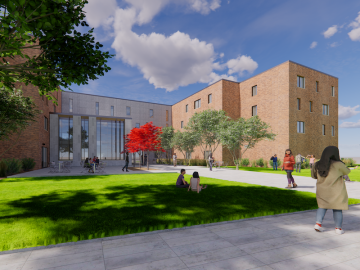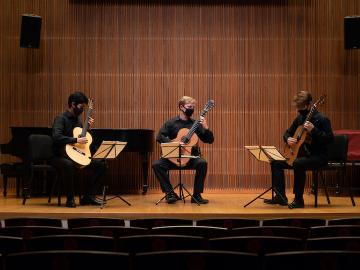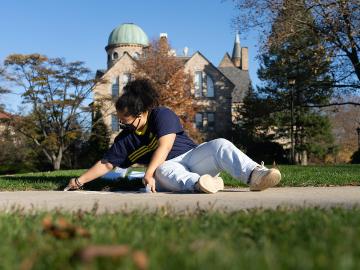Rallying Around Comic Art
May 8, 2013
Madeleine O'Meara
In a small room on the fourth floor of Wilder Hall, junior MJ Robinson and seniors Matt Davis and Sam Szabo huddle over a table littered with drawing utensils, looking over sketches and wondering what colors would look best on the cover of their next zine. So goes an afternoon in the office of the Oberlin College Comics Collective.
A group of students and community members interested in comics and looking for an opportunity to develop their skills, the Comics Collective was put together after the founders took a class on graphic narratives with Delaney Associate Professor of Creative Writing Dan Chaon last year. When some fellow students initially expressed interest in starting the Comics Collective, Robinson, Szabo, and Davis soon jumped on board.
“While I already had an interest in comics, I did not even consider making my own until I took the graphic narratives class,” says Szabo. “It really catalyzed my interest for making comics.”
The Comics Collective allows members to define their membership for themselves — participation is as scarce or as in-depth as the member decides. Even with 100 or so students on the mailing list, says Robinson, not everyone comes to every meeting, providing a different set of Collective members each time. When the meetings get too routine, the group holds drawing jams where the group plays drawing games and passes around stacks of comics. Not only is the jam a fun, informal way to encourage members to collaborate, but it also attracts aspiring cartoonists.
“We draw around stuff or draw on each other’s stuff or draw on each other. It’s the introvert’s version of a party," says Davis. To get the group up and running, the students worked to make the Comics Collective an official club. Robinson petitioned the Student Finance Committee for funding and secured an office in Wilder, and each student took on a role or two within the group to provide structure and organization. “It’s pretty important to us that it’s a collective, and everyone has the ability to be heard and take actions and lead,” says Robinson. “However, we have found that we do need some structure in place to be more efficient."
The group has several elected positions that assist in keeping the collective running smoothly. In addition to being the collective's production editor, Robinson manages overarching administrative tasks and ties up any loose ends. Davis coordinates the group of editors, and Szabo oversees work the printer and keeping a stock of supplies. The collective also has publicity coordinators who advertise for events and maintain the group’s Tumblr and Facebook — pages where any Oberlin cartoonist can publish comics.
To further strengthen group membership and encourage self-publication, members also hold "skillshare" workshops. These workshops usually focus on one aspect of producing comics — how to use the printer, bookbinding, and how to use Photoshop have been on the agenda.
Recently, the Collective has acquired a Risograph printer, a type of electronic mimeograph machine used by cartoonists who print their zines and comics themselves. “It’s a cheaper, cool way to get people thinking about and knowing about the printing process and what it means to self-publish,” says Robinson. “Part of our goal is to make that self-publishing process easy and give [the cartoonists] resources that they might not have if they weren’t here,” says Davis.
The Comic Collective’s anthology of student comics each semester is one way the group supports this goal. After their first publication in fall 2011, titled “Mutant Sister,” the group has put out an issue every semester. In addition to their blog, the Collective’s anthology is a unique opportunity for anyone to display their comics. “We’re all about inclusivity,” says Robinson. “If someone believes in their work and wants to see it printed, so do we. I think a really cool thing about comics is that the drawings don’t have to be well-rendered or technically good for the comic to be funny or poignant.”
Members attends several comics conventions each year. In early March, a few cartoonists in the Collective attended the Chicago ZineFest, where they were able to display and sell their comics, meet other cartoonists, and learn tricks of the trade. Members are also planning to attend the Small Press and Alternative Comics Expo (SPACE) in Columbus on April 13 and 14, as well as the Chicago Alternative Comics Expo (CAKE) and the Small Press Expo (SPX) in Bethesda, MD in September. Meeting other cartoonists expands their networks, enabling cartoonists to learn different techniques as well as exposure for their work and glean valuable experience.
The group commissions recognized cartoonists to bring this exposure to campus. Nicole J. Georges and Cassie J. Snyder — “long-time zinesters,” says Robinson — came to campus this semester to talk about their experiences self-publishing comics. “As a medium, the grassroots nature of independent comics is really cool because it’s such a community,” says Szabo. “Even the very successful artists in that community are very approachable.”
The Comics Collective seeks to bring this experience to the greater Oberlin community as well. They are currently collaborating with the Firelands Association of Visual Art (FAVA) to host a comics symposium geared towards children in grades three through twelve in the Oberlin area. The symposium, which would take place this spring, would consist of a one- or two-day series of workshops and drawing jams.
This collaboration, along with the multiple platforms the Comics Collective uses to reach aspiring cartoonists, provides ample opportunity for the Oberlin community to share their comics. “[The Comics Collective] encourage[s] people to draw comics and to publish them, to put them out there instead of keeping them in their sketchbooks,” says Robinson.
Tags:
You may also like…
Construction Begins on New Residence Hall
September 26, 2023
Four-story structure to house 400 students, accommodate campus-wide renovations to other residences.
This Week in Photos: The Soundtrack of Fall
November 27, 2020
A guitar ensemble performance in Kulas Recital Hall featured Suvan Agarwal '23, Aidan Wiley '20, and Craig Slagh '21. The passion demonstrated in their live streamed performance was captured in photos and chosen to be among the images included in this week’s photo series.
This Week in Photos: Creativity and Strength
November 13, 2020
Inspirational words and chalk drawn images on the sidewalks of Wilder Bowl greeted those passing by this past week. This chalk walk exercise resulted in several standout images featured in this week’s photo series.


